International Journal of
eISSN: 2576-4454


Research Article Volume 4 Issue 2
1Agricultural Science Center at Farmington, Department of Plant and Environmental Sciences, New Mexico State University, P.O. Box 1018, Farmington, NM 87499, USA
2Université Gaston Berger, BP 234-Saint-Louis, Sénégal
3ADA Consulting Africa, 07 BP 14284 Lomé, Togo
Correspondence: Koffi Djaman, Agricultural Science Center at Farmington, Department of Plant and Environmental Sciences, New Mexico State University, P.O. Box 1018, Farmington, NM 87499, USA, Tel +1-505-960-7757
Received: April 18, 2020 | Published: April 30, 2020
Citation: Djaman K, Diop L, Koudahe K, et al. Evaluation of temperature-based solar radiation models and their impact on Penman-Monteith reference evapotranspiration in a semiarid climate. Int J Hydro. 2020;4(2):84-95. DOI: 10.15406/ijh.2020.04.00230
Solar radiation is one of the most important climatic parameters that is involved in different environmental, hydrological, agricultural applications while not always measured at all weather stations due to the high equipment and maintenance cost. The objectives of this study were to evaluate the performance and accuracy of twenty temperature based solar radiation models at five weather stations (Alcalde, Fabian Garcia, Farmington, Leyendecker and Tucumcari) in New Mexico and to evaluate the impact of solar radiation prediction on the Penman-Monteith grass reference evapotranspiration (ETo) for the global period of 2009-2017. New constants of each model at each weather station were retrieved using the optimization procedure Solver in Excel that maximizes the Kling-Gupta Efficiency (KGE). The root mean squared error (RMSE), mean absolute error (MAE), mean bias error (MBE) and the Nash-Sutcliffe model efficiency coefficient (NSE) were used for model performance evaluation. The results showed that the Hargreaves and Samani (1982), improved by Allen 1995, Bristow-Campbell (1984), Hunt et al. (1998), Fan et al. (2018), Hassan et al. (2016), Samani (2000); Nage et al. (2018) 2 and the Richardson et al (2018) models were the most accurate and the best performing ones across all five research sites. The EL-Sabaii, Ert Yal and Clemence models showed the poorest performance at all five stations. The evaluation of the impact of the predicted solar radiation on the Penman-Monteith ETo showed that predicted solar radiation had non-significant effect of the daily ETo with a regression slope varying from 0.978 to 1.022, RMSE from 0.24 to 0.48 mm/day, MAE from 0.15 to 0.31 mm/day and MBE from -0.03 to 0.09 mm/day. All solar radiation models showed best performance at Farmington and Tucumcari while they registered the poorest performance at Alcalde. The Student T-test revealed non-significant differences between the daily ETo using the measured solar radiation data set and the predicted solar radiation by each of the twenty solar radiation models at each weather station. The new models developed in this study could be used to estimate daily solar radiation across the semiarid environment of New Mexico for satisfactory estimation of ETo.
Keywords: solar radiation, prediction, reference evapotranspiration, semiarid climate
Solar radiation is the main source of available energy for different physical and physiological activities on the earth including crop growth and development, photosynthesis, evaporation, transpiration, snow melt, cloud formation, and different forms of energy transfer. Despite its importance, solar radiation measurement is tedious and expensive in terms of equipment cost and maintenance in opposite to other climate variables such as air temperature, relative humidity, wind speed and precipitation.1,2 As one of the most important climate variables, numerous studies have been conducted to develop models estimating solar radiation. As a result, different solar radiation models have been developed, evaluated and calibrated across the globe.3‒11 Solar radiation models could be classified as temperature based, sunshine duration based, cloudiness and complex temperature - sunshine duration, temperature – precipitation, sunshine duration –precipitation or more complex models. Remote sensing and satellites are also used to retrieve solar radiation.12 Fan et al.13 evaluated different temperature based solar radiation models. They concluded that the incorporation of daily precipitation and relative humidity within the temperature based models, improved the accuracy of the simple models for estimating solar radiation in the humid subtropical and tropical regions of south China. Quej et al.14 also reported that the complex models based on air temperature, air relative humidity, and precipitation gave best performances compared to simple temperature based models. Recently, Feng et al.15 developed, evaluated and calibrated nineteen solar radiation models across 96 weather stations in China and reported that calibration improved the prediction accuracy of solar radiation with root mean squared error (RMSE) of 16.5% and daily mean absolute error (MAE) of 1.69MJm-2. From cross comparison of 300 sunshine-based solar radiation models in Nagpur (India), Makade and Jamil16 had shown that these models when calibrated to the local conditions gave best estimation. While most of the developed models are able to predict the daily solar radiation, their accuracy varies with the climatic zones and the quality of the available meteorological data. Model calibration to the local climatic conditions usually improves the performance and the accuracy of the models.13,15,17,18
Crop evapotranspiration (ETc) is an important parameter in hydrological, environmental and agricultural studies and plays a key role in designing and managing irrigation projects and water management under irrigated and rainfed agriculture. While crop ETc is directly measured with lysimeters, Bowen ratio energy balance system and Eddy covariance systems,19‒21 it is also estimated by the indirect method using reference crop evapotranspiration (ETo) and crop coefficients as proposed by Jensen.22‒24 Evapotranspiration is one of the largest components of the hydrological cycle and is expected to increase with the warming across the Southwestern United States.24 Water resources are limited under semiarid regions similar to the Southwestern United States, the hottest and driest region in the United States with diminishing winter and spring precipitation and shifts in precipitation and reference evapotranspiration.25‒28 This projection is mostly challenging regarding water resources management and planning when the human population is increasing along with the demand for food and an increasing competition among water users such as agricultural producers, industries, mines, communities, environmentalists and others. Prein et al.29 indicated that the southwestern United States climate may be transitioning to a drier climate state leading to higher drought risk. To cope with the aforementioned climatic conditions and the future projection, accurate estimation of crop water use may be a priority for water management and planning under conservative agriculture. Reference evapotranspiration (ETo) is estimated by different methods from direct measurements with lysimeters and Eddy covariance system to indirect modeling using local climatic variables.4,30‒37 Numerous ETo equations have been developed with different parameterizations. Their performance and adaptability vary throughout the globe and the Penman-Monteith equation is shown to be the most worldwide accurate under all types of climatic conditions.34,38‒46 However, the number of climatic variables required by the Penman-Monteith equation is the most limiting constraint for its adoption under limited data conditions. As aforementioned, solar radiation is the most scared measured variable and the simulation of this variable could partly help overcome data limitation for the Penman-Monteith equation adoption to improve water management under changing climate. The objectives of the present study were to (1) evaluate the performance of the nineteen existing and one developed temperature based solar radiation models and (2) evaluate the impact of the predicted solar radiation estimates on the Penman-Monteith grass reference evapotranspiration as a case study in a semiarid climate of the state of New Mexico.
Study area
This study was conducted at five weather stations across New Mexico (USA): Alcade, Fabian-Garcia, Farmington, Leyendecker and Tucumcari for the period of 2009-2017. The geographical coordinates and the long term average climatic variables at each station are summarized in Table 1. Minimum temperature (Tmin), maximum temperature (Tmax), minimum relative humidity (RHmin), maximum relative humidity (RHmax), wind speed (u2), and solar radiation (Rs) were collected on the daily basis from automated weather stations installed by the New Mexico Climate Center. The time series data were check for quality control following the methodology described by Allen et al.34
|
Parameters |
Alcalde |
Fabian garcia |
Farmington |
Leyendecker |
Tucumcari |
|
Latitude (Deg. North) |
36.09 |
32.28 |
36.69 |
32.20 |
35.20 |
|
Longitude (Deg. West) |
-106.06 |
-106.77 |
-108.31 |
-106.74 |
-103.69 |
|
Elevation (m) |
1735 |
1186 |
1720 |
1176 |
1246 |
|
Wind speed (m/s) |
1.19 |
1.82 |
2.45 |
1.81 |
3.30 |
|
Tmax (°C) |
21.09 |
26.50 |
20.94 |
26.12 |
24.07 |
|
Tmin (°C) |
2.22 |
9.82 |
4.33 |
7.67 |
7.52 |
|
Tmean (°C) |
11.65 |
18.16 |
12.63 |
16.89 |
15.79 |
|
RHmax (%) |
83.86 |
65.21 |
68.63 |
77.34 |
71.78 |
|
RHmin (%) |
22.88 |
18.60 |
19.70 |
19.09 |
22.29 |
|
RHmean (%) |
53.37 |
41.90 |
44.17 |
48.21 |
47.03 |
|
Rs (MJ m-2) |
18.62 |
21.23 |
19.84 |
19.63 |
19.80 |
Table 1 Weather stations with long term average climatic condition
Empirical methods to estimate daily solar radiation
Twenty empirical methods were used to estimate daily solar radiation in this research. One simple equation with any exponet (equation 21) was developped in this study to facilited solar radiation estimation with very basic tools as most of the ranchers across the study area are within the upper age class and have limited accress to the highly efficiency estimation tools. The selected models are:
Hargreaves and Samani3 and Allen47
(1)
(2)
Bristow-Campbell5
(3)
Hargreaves and Samani4
(4)
Clemence48
Rs= a (b*Ro*T+c Tmax T+d T+e) (5)
(6)
Hunt et al.10
(7)
Ertekin-Yaldiz49
(8)
Samani6
(9)
Annandale et al.50
(10)
Chen et al.9 named Chen1
(11)
Chen et al.9 named Chen2 Hargreaves et al.51
(12)
El-Sebaii et al.52
Rs=(a+b*T+c*RH)*Ro (13)
Benghanem and Mellit.53
Rs=a*Ro*∆T0.25+b (14)
Hassan et al.8
(15)
Rao et al.54
(16)
Jahani et al.1
(17)
Fan et al.13
(18)
Nage et al.55 named Nage1
(19)
Nage et al.55 named Nage2
(20)
Richardson et al.56
(21)
Djaman et al.
(22)
where Ro=the daily extraterrestrial solar radiation (MJm-2) determinded following the procedure described by Allen et al.34; 𝞓T=(Tmax-Tmin); T=(Tmax+Tmin)/2; T, 𝞓T, Tmax and Tmin in oC; RH=mean relative humidity (%); Z=station altitude (m); a, b, c, d and e are dimenssionless empirical constants to be determined during the calibration process.
Penman-monteith reference evapotranspiration
Daily grass-reference evapotranspiration was computed using the standardized ASCE form of the Penman–Monteith equation38 (Equation 22):
(23)
where, ETo is reference evapotranspiration (mm/day), Δ is the slope of saturation vapor pressure versus air temperature curve (kPaoC-1), Rn=net radiation at the crop surface (MJ m-2 d-1), G=soil heat flux density at the soil surface (MJ m-2 d-1), Tmax and Tmin are maximum and minimum air temperature (0C), T=mean daily air temperature at 1.5-2.5m height (oC), u2=mean daily wind speed at 2m height (m s-1), es=the saturation vapor pressure (kPa), ea=the actual vapor pressure (kPa), es-ea=saturation vapor pressure deficit (kPa), γ=psychrometric constant (kPa oC-1),. Rs=solar radiation (MJ m-2 d-1). All parameters necessary for computing ETo were computed according to the procedure developed in FAO-56 by Allen et al.34
Calibration of the daily solar irradiation models
The original solar radiation equations were calibrated to the local semiarid and dry climatic conditions of each location. These solar radiation equations were calibrated using the measured daily solar radiation data and the generalized reduced gradient method. This procedure allows iterations by changing the constants in the equations to create new equations for each location. The solver add-in Excel is a tool that was used to fit the original equations by minimizing the sum of the squared residuals. Multiple initial values were tested to ensure that the global minimum of the errors was found57 and maximum value of the Kling-Gupta efficiency (KGE)58 was reached. For model evaluation, simple linear regression was used to compare the daily solar radiation estimates by the temperature based solar radiation models and the measured daily solar radiation at each weather station. The intercept of the regression line was forced to be zero. The more accurate the solar radiation equation is the more the regression slope and the coefficient of determination are close to unity. The coefficient of determination R2, the Kling-Gupta efficiency (KGE),58 Root mean square error (RMSE), Nash-Sutcliffe model efficiency coefficient (NSE), and the mean absolute error (MAE)18 were also used for model evaluation. The objective function was to maximize R2 and KGE (the higher R2 and KGE are, the better is the simulation process) and to minimize RMSE, MAE, NSE, and MBE. The sign of the MBE indicates overestimation of the solar radiation estimates (MBE>0) or underestimation of the solar radiation estimates (MBE<0).
Evaluation of the impact of solar radiation simulated by empirical models on the Penman-Monteith reference evapotranspiration estimates
The measured and predicted daily solar radiation were interchanged in combination with all other required weather variables (Tmax, Tmin, RHmax, RHmin and U2) to estimate daily ETo under both conditions. The Penman-Monteith ETo (ETo-PM-meas) estimates using the measured daily solar radiation was compared to the one using the predicted daily solar radiation by the temperature based solar radiation models (ETo-PM-pred) using simple linear regression with the intercept forced to be zero. The evaluation criteria used for solar radiation models evaluation are also used for the evaluation of the impact of the solar radiation models on the Penman-Monteith reference evapotranspiration estimates. In addition, Student T-test was used to compare the ETo-PM-meas and ETo-PM-pred across all models and weather stations to determine any significant difference between the original ETo estimates and the predicted ETo values using predicted solar radiation values at 95% level of confidence.
Calibration and evaluation of the solar radiation models
The selected solar radiation models showed different performance and accuracy at each of the five weather stations under this study (Figures 1‒3). The best fitting constants that optimized the daily solar radiation estimation at each weather station and for each of the selected models are summarized in Table 2. The boxplots of the performance criteria are presented in Figure 1. The Kling-Gupta efficiency (KGE) varied with model and locations and ranged from 0.69 to 0.91 (Figure 2). The best model at all five weather stations combined with the greatest accuracy was the Hassan’s model obtaining an average medium KGE value of 0.90 followed by Fan et al., Bist Camp, Samani and Cichar and the models. The lowest KGE values were obtained for the Benghamen, EsSebaii, Ert Yal and Clemence models (Figure 1). Clemence showed the lowest medium KGE value of 0.79. All models performed better at Farmington followed by Tucumcari, Fabian Garcia and Alcalde (Figure 2). Considering average KGE value, Hassan’s model was the best performing model (KGE value=0.89) and Benghamen and Clemence are the least performing models with average KGE value of 0.80.
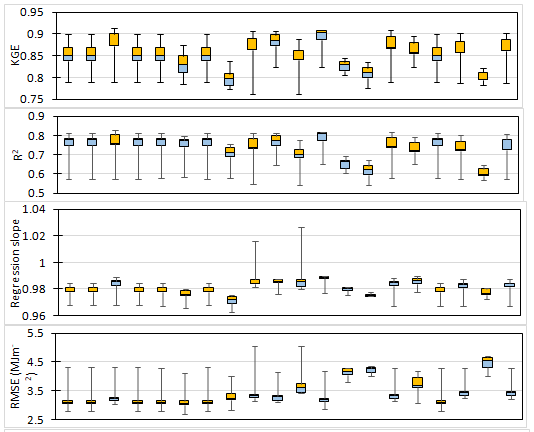

Figure 1 Boxplots of the statistics evaluation criteria for solar radiation models at five weather stations (pooled) in New Mexico.
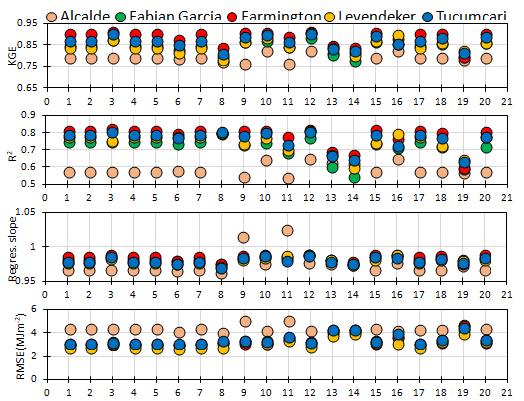
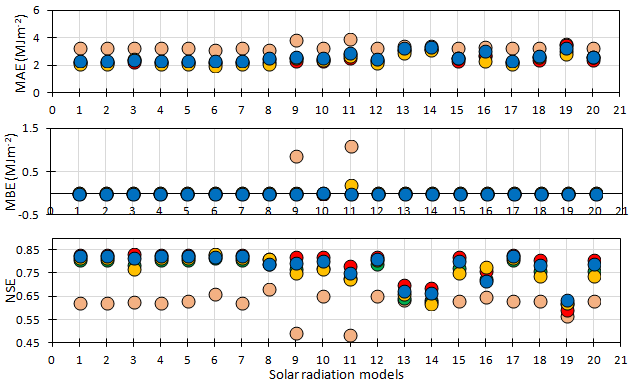
Figure 2 KGE, R2, regression slope, root mean squared error (RMSE), mean bias error (MBE), mean absolute error (MAE) and Nash-Sutcliffe model efficiency coefficient (NSE) between the measured and the predicted daily solar radiation using different solar radiation models at Alcalde. Fabian Garcia, Farmington, Leyendecker, and Tucumcari. The order of the solar radiation models 1, 2, 3…, 20 is the same as in Figure 1.
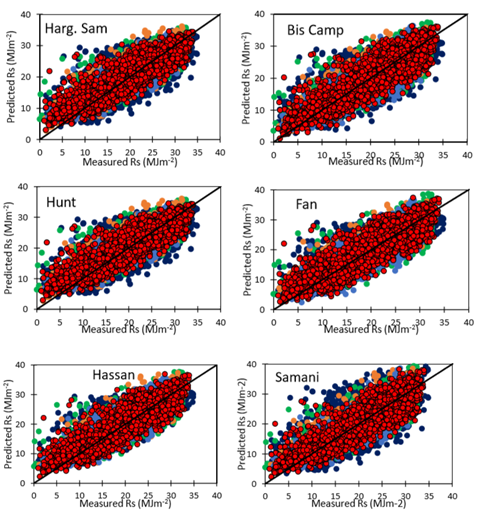
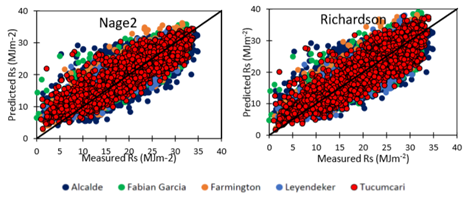
Figure 3 Regression plotting between the measured and the predicted daily solar radiation by the best eight solar radiation models at Alcalde. Fabian Garcia, Farmington, Leyendecker, and Tucumcari.
|
Solar radiation models |
Coeff. |
1 |
2 |
3 |
4 |
5 |
Average |
Solar radiation models |
Coeff. |
1 |
2 |
3 |
4 |
5 |
Average |
|
Hargreaves and Samani (1982) |
a |
0.15985 |
0.18135 |
0.17575 |
0.16014 |
0.17637 |
0.17069 |
Rao et al. (2017) |
a |
0.22648 |
0.17053 |
0.19466 |
0.14497 |
0.14785 |
0.17690 |
|
Bristow-Campbell (1984) |
a |
0.82118 |
1.23935 |
1.03183 |
1.28326 |
1.25769 |
1.12666 |
b |
0.23193 |
0.34040 |
0.29181 |
0.34302 |
0.36613 |
0.31466 |
|
|
b |
0.03628 |
0.02876 |
0.03163 |
0.02516 |
0.02771 |
0.02991 |
Johani et al. (2017) |
a |
0.40000 |
0.43213 |
0.44606 |
0.40000 |
0.38743 |
0.41312 |
|
|
c |
2.17650 |
1.72560 |
1.89798 |
1.50981 |
1.66258 |
1.79449 |
b |
0.00014 |
0.00014 |
0.00014 |
0.00014 |
0.00014 |
0.00014 |
||
|
Hargreaves and Samani (1985) |
a |
0.14417 |
0.16907 |
0.15865 |
0.14938 |
0.16384 |
0.15702 |
c |
0.00066 |
0.00085 |
0.00066 |
0.00066 |
0.00092 |
0.00075 |
|
|
Hunt et al. (1998) |
a |
0.14417 |
0.16907 |
0.15865 |
0.14938 |
0.16384 |
0.15702 |
d |
0 |
0 |
0 |
0 |
0 |
0 |
|
|
b |
0 |
0 |
0 |
0 |
0 |
0 |
Fan et al. (2018) |
a |
0.37133 |
0 |
0 |
0 |
0 |
0.07427 |
|
|
Ertekin-Yaldiz (1999) |
a |
0 |
0 |
0 |
0 |
0 |
0 |
b |
0.00799 |
0.01538 |
0.00004 |
0.01359 |
0.02006 |
0.01141 |
|
|
b |
0.50343 |
0.48641 |
0.53594 |
0.42944 |
0.47701 |
0.48645 |
c |
0 |
0 |
0 |
0 |
0.12785 |
0.02557 |
||
|
c |
0.30923 |
0.32963 |
0.27483 |
0.37626 |
0.35130 |
0.32825 |
d |
0.00000 |
0.08203 |
0.15072 |
0.05612 |
0.00018 |
0.05781 |
||
|
Samani (2000) |
a |
0.11559 |
0.13913 |
0.15193 |
0.11559 |
0.12700 |
0.12985 |
e |
0.25630 |
0.16629 |
0.07692 |
0.26751 |
0.13563 |
0.18053 |
|
|
b |
0.00177 |
0.00177 |
0.00008 |
0.00177 |
0.00214 |
0.00151 |
Nage et al. (2018) 1 |
a |
0.00019 |
0.00024 |
0.00021 |
0.00024 |
0.00024 |
0.00022 |
|
|
c |
0 |
0 |
0 |
0 |
0 |
0 |
b |
0.48551 |
0.51747 |
0.49682 |
0.45949 |
0.50041 |
0.49194 |
||
|
Annandale et al. (2002) |
a |
0.13772 |
0.16383 |
0.15161 |
0.14478 |
0.15851 |
0.15129 |
Nage et al. (2018) 2 |
a |
0 |
0 |
0 |
0 |
0 |
0 |
|
Chen et al. (2004) 1 |
a |
0.13907 |
0.16907 |
0.15865 |
0.14938 |
0.16384 |
0.15600 |
b |
0.11963 |
0.16907 |
0.15865 |
0.14938 |
0.16384 |
0.15212 |
|
|
b |
0.02209 |
0 |
0 |
0 |
0 |
0.00442 |
c |
0.03651 |
0 |
0 |
0 |
0 |
0.00730 |
||
|
Chen et al. (2004) 2 |
a |
0 |
0 |
0 |
0 |
0 |
0 |
Richardson et al. (2018) |
a |
0.15314 |
0.10283 |
0.12145 |
0.07889 |
0.09021 |
0.10931 |
|
b |
0.21455 |
0.24573 |
0.23176 |
0.22096 |
0.23895 |
0.23039 |
b |
0.47953 |
0.67739 |
0.59416 |
0.71851 |
0.71144 |
0.63621 |
||
|
El-Sebaii et al. (2009) |
a |
0.52989 |
0.55801 |
0.55265 |
0.50131 |
0.53993 |
0.53636 |
Clemence |
a |
0.37093 |
0.43187 |
0.44511 |
0.42100 |
0.35052 |
0.40389 |
|
b |
0.00683 |
0.00608 |
0.00647 |
0.00716 |
0.00681 |
0.00667 |
b |
0.10016 |
0.08149 |
0.06678 |
0.08435 |
0.07407 |
0.08137 |
||
|
c |
0 |
0 |
0 |
0 |
0 |
0 |
c |
1.12916 |
1.68926 |
1.18619 |
1.58008 |
1.22095 |
1.36113 |
||
|
Benghanem and Mellit. (2014) |
a |
0.30076 |
0.33958 |
0.32166 |
0.30877 |
0.33034 |
0.32022 |
d |
0.09515 |
0.08493 |
0.06842 |
0.08593 |
0.05850 |
0.07859 |
|
|
b |
0 |
0 |
0 |
0 |
0 |
0 |
e |
15.70956 |
0 |
13.90342 |
0 |
14.99549 |
8.92170 |
||
|
Hassan et al. (2016) |
a |
0.29538 |
0.14109 |
0.13856 |
0.13149 |
0.12809 |
0.16692 |
Djaman |
a |
0.30346 |
0.19989 |
0.25003 |
0.15982 |
0.16040 |
0.21472 |
|
b |
0.00309 |
0.00091 |
0.00024 |
0.00138 |
0.00058 |
0.00124 |
b |
0.01678 |
0.02923 |
0.02348 |
0.02582 |
0.03014 |
0.02509 |
||
|
c |
0.20984 |
0.52149 |
0.53844 |
0.48282 |
0.55926 |
0.46237 |
|
|
|
|
|
|
|
|
Table 2 Constants of the selected solar radiation models derived at the five weather stations from the fitting calibration using Solver in Excel
1, Alcalde; 2, Fabian Garcia; 3, Farmington; 4, Leyendecker; 5, Tucumcari;
The coefficient of determination of the regression between the measured and the predicted daily solar radiation estimates was dependent on the model. The boxplots of R2 showed that most of the models obtained moderately high values except for the El-Sebaii, Ert Yal and Clemence models with R2 values lower than 0.70. However, when most models showed boxplot high median R2 value, the minimum R2 values were quite low between 0.54 and 0.58. All models showed the highest R2 values at Farmington weather station and the lowest R2 values at Alcalde weather station (Figure 2). The highest and the lowest values of R2 were showed by Bist Camp model and Johani model, respectively (Figure 1).
High regression slope between the measured and the predicted daily solar radiation values were obtained and varied from 0.96 and 1.03 (Figure 2). The boxplots showed that the regression slope values are lower than unity for most of the models with the boxes below the y=1 line while Samani and Johani showed maximum value greater than unity, indicating solar radiation overestimation at Alcalde (Figure 2). Hassan’s model was still the best performing model and the Berghamen’s model showed the lowest regression slope. All models showed the lowest regression slope at Alcalde except Samani and Johani models.
Root mean square error (RMSE) of the predicted daily solar radiation estimates varied within a wide range between 2.67 and 5.71MJm-2 as shown in Figure 2. RMSEvalues were concentrated between 3 and 3.5MJm-2 for most of the models except for Johani, El Sebaii, Ert-Yal, Nage1 and Clemence models which showed higher RMSE values (Figure 1). Overall, models showed the lowest RMSE values at Leyendecker while they showed the highest RMSE values at Alcalde and the intermediate RMSE values were obtained at Farmington and Tucumcari. The Samani and Johani models showed the highest RMSE at Alcalde and the lowest RMSE value was shown by Chen2 at Leyendecker (Figure 2).
The mean absolute error (MAE) ranged from 2.36 to 3.87MJm-2 (Figure 2). The boxplots showed low MAE with most of the boxes within the range of 2.2–2.7 (Figure 1). Johani, El-Sebaii, Ert YAl, Nage1 and Clemence models showed great MAE while all models showed the maximum MAE greater than 3MJm-2 at Alcalde (Figure 1). Similar to the RMSE, the highest MAE values were obtained at Alcalde and the lowest MAE were registered at Leyendecker (Figure 2). Overall, the model Chen2 showed the lowest MAE value of 2.40MJm-2 and the highest MAE value of 3.26MJm-2 was obtained by Clemence model. The mean bias error (MBE) were quite low and ranged between -0.01 and 1.07MJm-2. Only Samani and Johani models showed MBE values of 0.85 and 1.08MJm-2 at Alcalde, respectively, and Johani showed MBE value of 0.18MJm-2 at Leyendecker as the highest MBE values (Figure 2). The Nash-Sutcliffe model efficiency coefficient (NSE) varied from 0.49 to 0.83 while most of the NSE boxplots are within the range of 0.75-0.83. El-Sebaii, Ert Yal and Clemence models have the boxes below 0.7 and the Samani and Johani models showed the lowest values of NSE (Figure 2). The lowest values of the NSE recorded at Alcalde for all models and very clustered values were observed at Fabien Garcia, Farmington, Leyendecker and Tucumcari (Figure 2).
From the combination of all the evaluation criteria, the most accurate and best performing solar radiation models across New Mexico were: Hargreaves and Samani3 improved by Allen,47 Bristow-Campbell,5 Hunt et al.,10 Fan et al.,13 Hassan et al.,8 Samani;6 Nage et al.55 2, Richardson et al.56 Daily solar radiation estimates by these top eight best performing models were plotted against the mesured daily solar radiation at all five weather stations and satisfactory superposed as shown in Figure 3. Threfore, these models could be used to simulated daily solar radiation using air maximum, minimum and average temparature in New Mexico. The results of this study are in agreement with Jamil et al.59 who had predicted solar radiation from the temperature extremes using 33 different models in India. The most accurate and best performing models according to their study were three models of Hassan et al.8 One the Hassan’s model was shown as one of the most accurate models across the semiarid environment of New Mexico. Bristow-Campbell and Hargreaves and Samani models were evaluated with satisfactory in Chile by Meza and Varas.60 Bandyopadhyay et al.61 found that the Hargreaves model was the best model for estimating solar radiation from air maximum and minimum temperatures while Tabari et al.62 reported one of Chen models and the improved Hargreaves model by Allen47 to be the best performing ones across the cool semiarid climate while the same models in addition to Annandale model performed better in the arid region in Iran. They indicated that Ertekin-Yaldiz model showed better performance in the cool semiarid environment than other climatic regions. Hargreaves and Samani model was used to predict solar radiation in Spain with high R2 value of 0.87.63 Li et al.64 reported that the modified Hargreaves and Chen models performed better than the original models. Valiantzas65 modified the Hargreaves-Samani model and proposed a new model which performed well using data from California, Arizona in the Southwest United States. Estévez et al.66 and Grillone et al.67 had shown the applicability of different solar radiation models after recalibration to local conditions. While diverse results were obtained from solar radiation models evaluation under different climatic conditions across the globe, the performance of these models is improved by site specific calibration and model choice may consider the climatic conditions under which the models were developed and the available data should be check for data quality control.
Impact of the predicted solar radiation on the Penman-Monteith reference evapotranspiration
Daily grass reference evapotranspiration was estimated by the Penman-Monteith equation using the measured solar radiation and the predicted solar radiation by the selected solar radiation models. The impact of the solar radiation prediction accuracy on the performance of the Penman-Monteith equation was drawn and the results showed that solar radiation prediction accuracy had a little effect on the reference evapotranspiration estimates. The coefficient of determination of the simple linear regression line between the ETo-PM-meas and the ETo-PM-pred varied with locations and solar radiation model used. It ranged from 0.94 to 0.99 and the highest R2 value were observed at Farmington and Tucumcari for all solar radiation models. The lowest R2 values were registered at Alcalde (Figure 4).

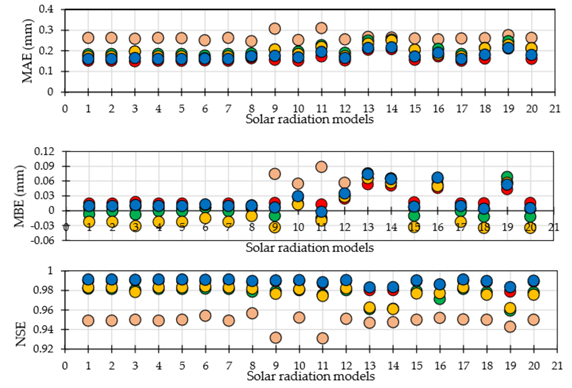
Figure 4 R2, regression slope, root mean squared error (RMSE), mean bias error (MBE), and mean absolute error (MAE) and Nash-Sutcliffe model efficiency coefficient (NSE) between the original and the predicted daily reference evapotranspiration using predicted daily solar radiation with the different models at Alcalde, Fabian Garcia, Farmington, Leyendecker, and Tucumcari. The order of the solar radiation models 1, 2, 3…, 20 is the same as in Figure 1.
The regression slope varied from 0.978 to 1.022 showing the relatively high correlation between the two sources of ETo estimates. Slight overestimation of ETo was mostly observed at Farmington with a regression slope greater than unity however, the highest ETo overestimation was obtained at Alcalde when daily solar radiation was predicted by the Samani, Fan, El-Sabaii, and Johani models. Daily ETo was systematically overestimated at all five stations when the solar radiation was predicted by the Hassan, El Sebaii, Ert Yal, Nage1 and Clemence models (Figure 4). Overall, the lowest regression slope was obtained at Leyendecker and the maximum ETo overestimation and underestimation equal to 2.2% seems to be reasonable.
Low RMSE of ETo estimates were obtained and varied from 0.24 to 0.48mm/day with the highest RMSE observed at the Alcalde (Figure 4). Similarly, very low MAE and MBE values were observed and ranged from 0.15 to 0.31mm/day (Figure 4) and from -0.03 to 0.09mm/day (Figure 4), respectively. The highest MAE values were obtained at Alcalde and the lowest values were obtained at Farmington (Figure 4) while the lowest MBE values were obtained at Leyendecker and the highest MBE value were not systematically obtained at only one station. Solar radiation predicted by Samani, Fan et al, Hassan, El-Sebaii, ERt Yal, Nage1 and Clemence models are sources of the high MBE of the predicted ETo values. The overall performance of the solar radiation models showed non-significant impact on the ETo estimates and the Nash-Sutcliffe model efficiency coefficient (NSE) values were quite high and varied from 0.93 to 0.99 with the lowest values of NSE observed at Alcalde and the highest NSE values observed at Farmington and Tucumcari across all solar radiation models (Figure 4). NSE values averaged 0.95, 0.98. 0.99, 0.98 and 0.99 at Alcalde, Fabian Garcia, Farmington, Leyendecker and Tucumcari, respectively.
The Student T-test revealed non-significant differences between the original and the predicted ETo values across all five weather stations using any of the 20solar radiation models. Consequently, the different solar radiation models have non-significant impact on estimating daily grass reference evapotranspiration. The good fitness of the predicted ETo versus the observed ETo estimates is shown in Figure 5 presenting the impact of the best eight solar radiation models on ETo estimates. These results are in agreement with Tabari et al.62 and Bandyopadhyay et al.61 who reported that the solar radiation prediction model choice had a little impact on the reference evapotranspiration estimates. Tabari et al.62 reported no noticeable improvement in ETo estimates when daily solar radiation data was predicted by the Hargreaves-Samani, Allen, Samani, Annandale, Chen and Ertekin-Yaldiz models with Penman-Monteith ETo deviation range between from -2.16 to 1.40mm between the original and the calibrated solar radiation.
Performance and accuracy of twenty temperature based solar radiation models were evaluated at five weather stations in New Mexico for the global period of 2009-2017 using the optimization procedure Solver in Excel which maximized the Kling-Gupta Efficiency. The results showed that the Hargreaves and Samani3 improved by Allen,47 Bristow-Campbell,5 Hunt et al.,10 Fan et al.,13 Hassan et al.,8 Samani,6 Nage55 2, and Richardson56 models were the most accurate and the best performing ones across all research sites with the highest Kling-Gupta Efficiency, the root mean squared error (RMSE), mean absolute error (MAE), mean bias error (MBE), and the Nash-Sutcliffe model efficiency coefficient. The evaluation of the impact of the predicted solar radiation on the Penman-Monteith reference evapotranspiration showed that the predicted solar radiation had non-significant effect of the daily reference evapotranspiration with regression slopes varying from 0.978 to 1.022, RMSE from 0.24 to 0.48mm/day, MAE from 0.15 to 0.31mm/day and MBE from -0.03 to 0.09mm/day. These best performing solar radiation models could be considered as the alternatives for estimating daily solar radiation across New Mexico when solar radiation is missing and for predicting daily reference evapotranspiration across the study area.
We completed this work with the support of New Mexico State University (NMSU) and the Agricultural Science Center at Farmington and all the staff.
The authors declare no conflict of interest.
None.

©2020 Djaman, et al. This is an open access article distributed under the terms of the, which permits unrestricted use, distribution, and build upon your work non-commercially.